Troubleshooting Voice Delay Problems After Core Network Upgrade

Troubleshooting Voice Delay Problems After Core Network Upgrade
 picture
picture
After an operator's core network was upgraded, big data showed that the voice connection delay was slightly improved.
 picture
picture
Performance statistical analysis
According to big data statistics, after the upgrade of the core network is completed, the indicators of the voice service fluctuate as follows.
1. The average delay indicator of EPSFB increased by about 50ms, and then stabilized, as shown in Figure 1.
 Figure 1 Switch-on delay
Figure 1 Switch-on delay
2. The average duration of EPSFB in the core network has increased by about 40~50ms, a slight increase, as shown in Figure 2.
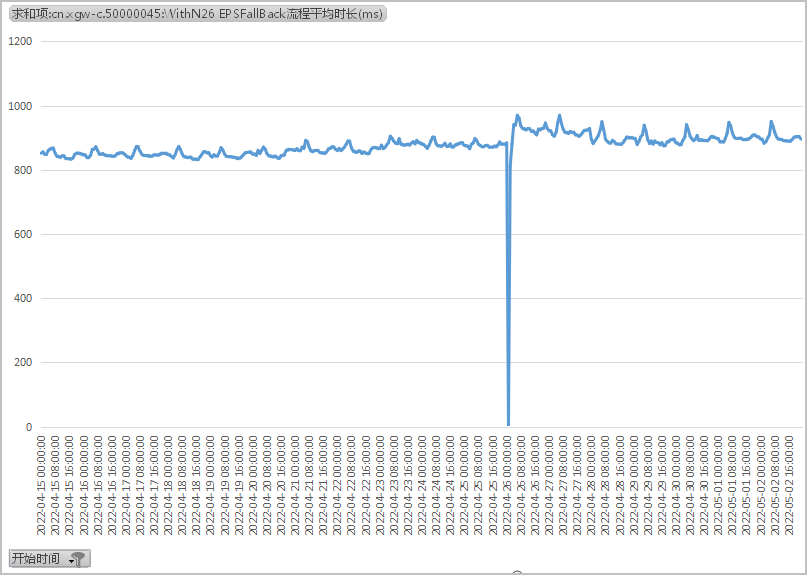 Figure 2 Average duration of EPSFB process
Figure 2 Average duration of EPSFB process
3. The process success rate index of the core network EPSFB increased by about 1% after the upgrade, which is a significant improvement, as shown in Figure 3.
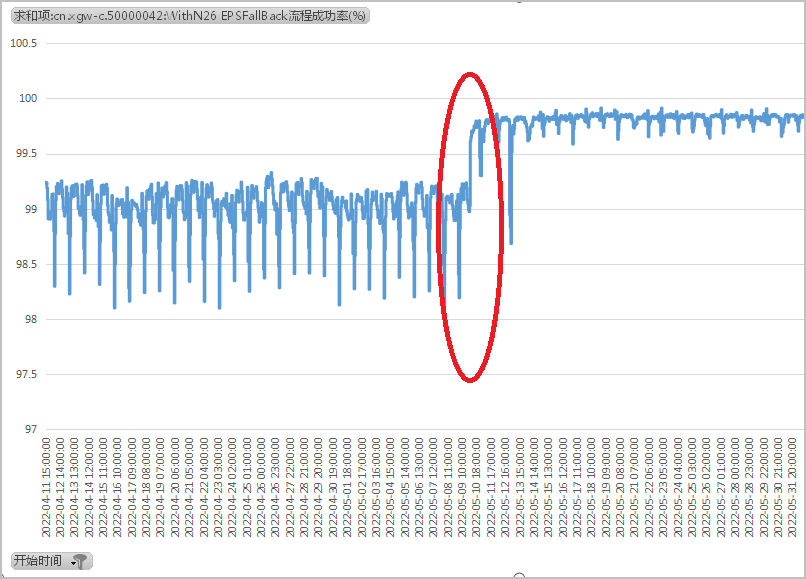 Figure 3 Success rate indicator
Figure 3 Success rate indicator
4. The EPSFB indicators after the core network upgrade in other provinces are summarized are the same, as shown in Figure 4 and Figure 5.
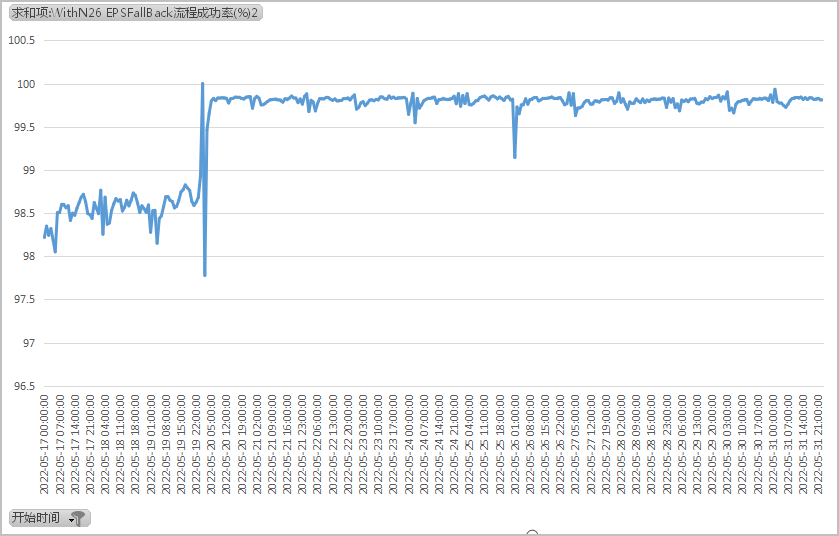 Figure 4 Process success rate
Figure 4 Process success rate
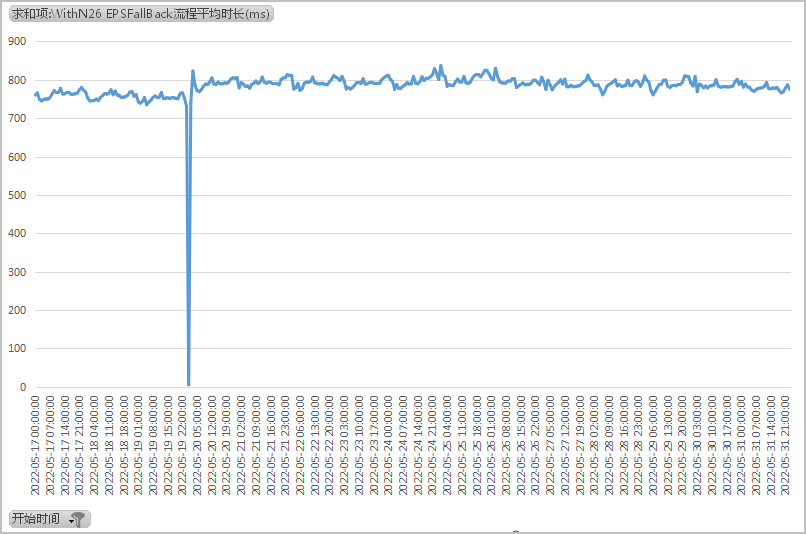 Figure 5 Average process duration
Figure 5 Average process duration
5. The average delay indicator of VoNR has no change. However, the delay index showed a large increase and fluctuation after one week, as shown in Figure 6.
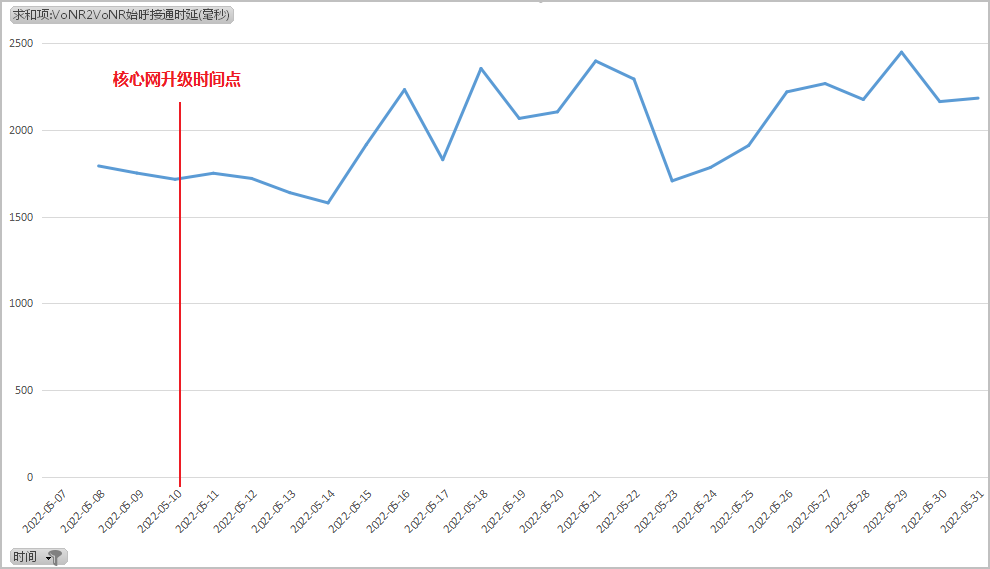 Figure 6 Latency indicator
Figure 6 Latency indicator
6. Through the analysis of big data results, when the number of VoNR calls made by VoNR decreases, the delay will increase and fluctuate greatly, as shown in Figure 7.
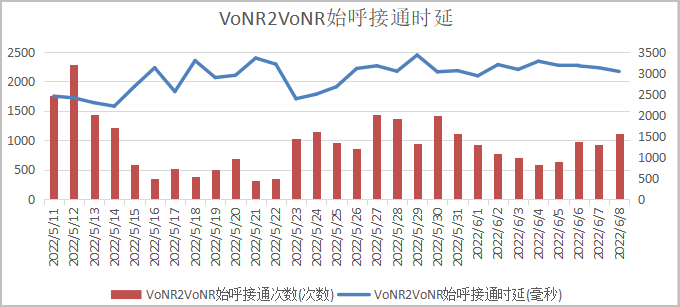 Figure 7 Switch-on delay
Figure 7 Switch-on delay
7. Subdivide the indicators of VoNR calling VoNR in each city. When the number of calls decreases, the delay will increase, and when the number of calls increases, the delay will decrease. It can be seen that when the total number of calls is small, too little data sampling has a greater impact on delay fluctuations, as shown in Figure 8.
 Figure 8 Comparison of city indicators
Figure 8 Comparison of city indicators
8. Summarize through statistics:
a. EPSFB success rate The core network has been greatly improved after the upgrade, and the average delay of the process has increased slightly.
b. VoNR2VoNR success rate and delay have no obvious change after core network upgrade. The fluctuation of VoNR2VoNR delay is affected by the number of calls. When the number of statistical sampling is large, the delay will tend to the real average delay value.
Business summary analysis
Comprehensive performance statistical analysis results show that after this upgrade of the core network, the voice service process, especially EPSFB, has been optimized to improve the success rate, but it has also introduced a small increase in average delay. According to this result, the core network side analysis results are as follows.
1. In the voice process, the SMF side has carried out a lot of process optimization. While establishing a dedicated load, SMF received event conflicts from other processes (for example, forward Xn handover was received). SMF will handle process conflicts. The current process conflict policy of SMF is 3s x 2 times, that is, every time a conflict/timeout of a voice specific load is established, it will try to rebuild after 3 seconds, and try to establish a maximum of 2 times.
2. Pre-upgrade processing of SMF: Before the upgrade, all SMF event conflicts share the same policy configuration, causing conflict processes such as Xn switching to occupy the total conflict policy times. Dedicated establishment cannot be triggered after the conflict because the maximum number of 2 times is exhausted. Voice The call fails directly.
3. Post-SMF upgrade processing: After SMF upgrade, the conflict policies of the voice process, NGC process, and EPC process are configured differently, and the same policy configuration is no longer shared. NGC process conflicts (such as Xn switching) no longer occupy the number of conflicts of voice processes, as shown in Figure 9.
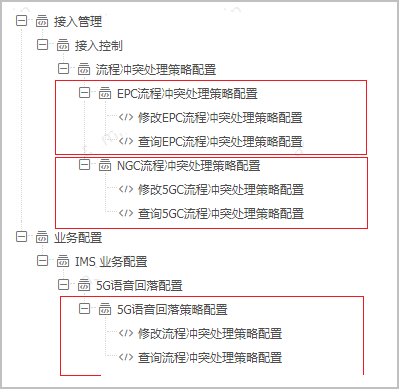 picture
picture
Figure 9 Configuration Diagram
4. Therefore, after the SMF version is upgraded, the voice creation process conflicts with the business process, and SMF can ensure that the process of setting up the voice process will continue to pop up for retrying to ensure that the voice process can be successful.
5. The impact of this optimization on the EPSFB process is shown in Figure 10.
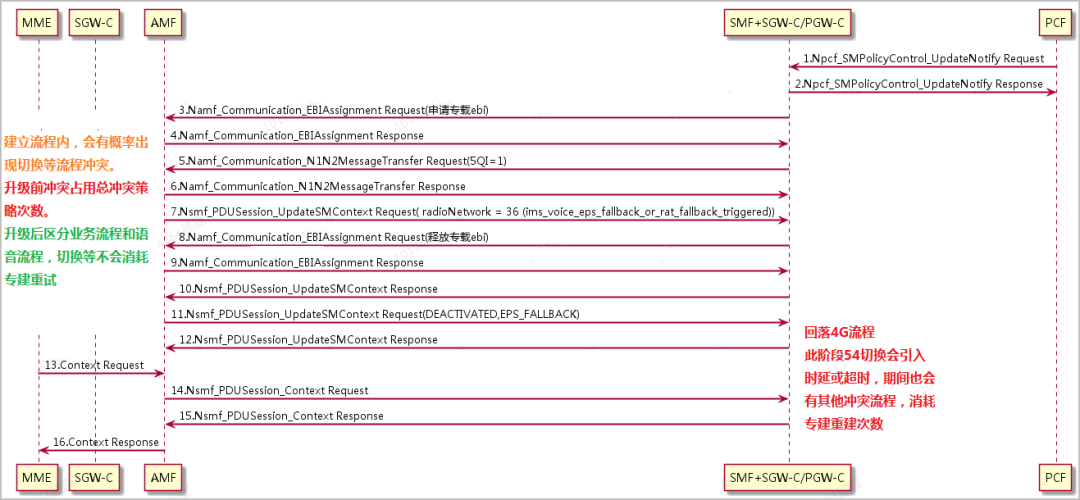 Figure 10 EPSFB signaling process
Figure 10 EPSFB signaling process
a. Since EPSFB needs to switch from 5G to 4G, there are many process interaction messages, and the probability of conflicts caused during this period is relatively high.
b. Under multiple conflicts in the version before the upgrade, because the conflict strategy was not distinguished, the follow-up voice could not try to rebuild the dedicated load (the number of times was exhausted).
c. This upgrade optimizes the distinction between conflicting policy implementation types. The process that failed before the upgrade can be successfully reconstructed after the upgrade through a reasonable dedicated load reconstruction method, but the total delay of EPSFB establishment this time is not less than 3 seconds (overtime reconstruction process must be performed), so this part of the process will improve the EPSFB at the same time success rate and latency.
6. The impact of this optimization on the VoNR process is shown in Figure 11.
 Figure 11 VoNR signaling process
Figure 11 VoNR signaling process
a. VoNR does not need to switch from 5G to 4G in the voice process, the overall delay and process are reduced, and there are fewer intervals for multiple conflicts. Although this optimization is applicable to the VoNR process, the trigger probability is low due to the small conflict scenarios.
b. Therefore, the core network upgrade has no obvious change to the overall time delay of VoNR.
7. VoNR delay analysis is shown in Figure 12.
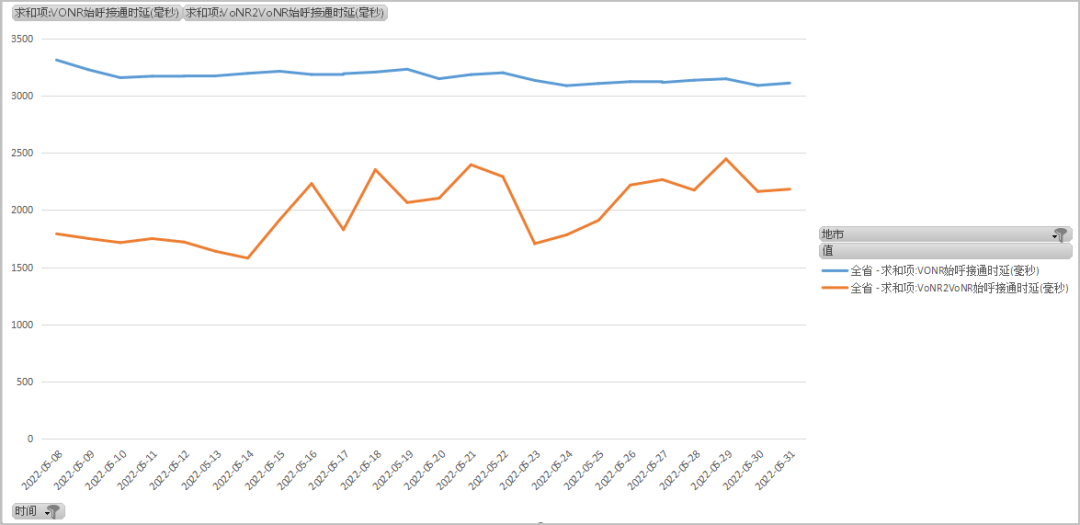 Figure 12 VoNR delay analysis
Figure 12 VoNR delay analysis
a. VoNR initial call delay index (VoNR calling, called including EPSFB), has been showing a stable trend.
b. VoNR2VoNR delay index (both caller and called party are VoNR), fluctuate greatly with the increase of users.
c. Therefore, the time delay of VoNR is mainly generated in the process of the called side.
d. Obtain high-latency VoNR call VoNR session signaling backtracking through big data. Calls with increased delay are due to the increase in delay caused by the called party's multiple paging.
e. User 1 signaling is shown in Figures 13 and 14 .
 Figure 13 User 1 signaling process 1
Figure 13 User 1 signaling process 1
 Figure 14 User 1 signaling process 2
Figure 14 User 1 signaling process 2
f. User 2 signaling is shown in Figures 15 and 16 .
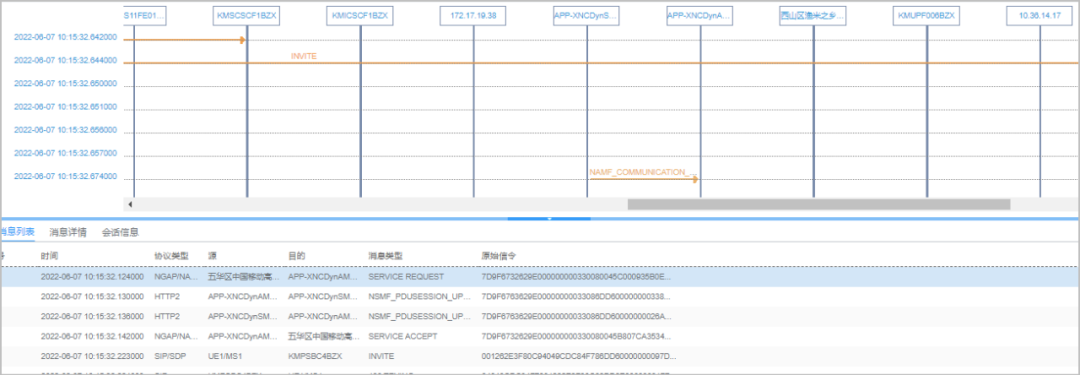 Figure 15 User 2 signaling process 1
Figure 15 User 2 signaling process 1
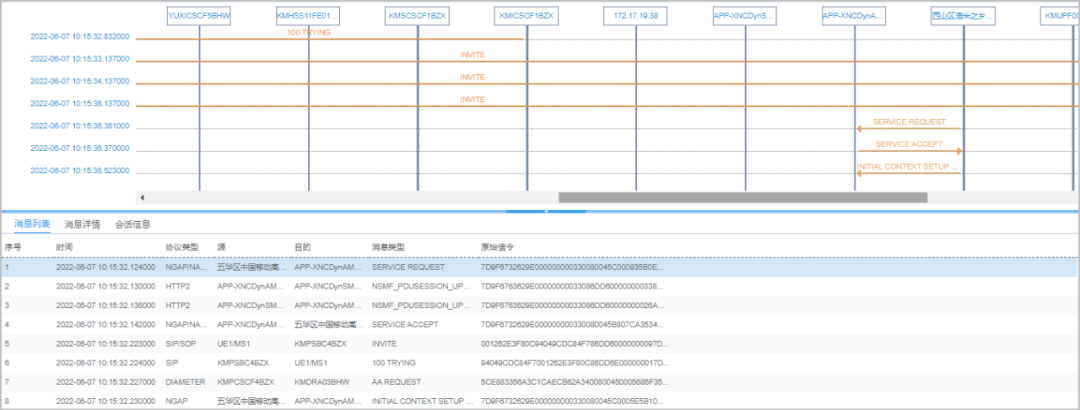 Figure 16 User 2 signaling process 2
Figure 16 User 2 signaling process 2
Associated with the number of mutual VoNR calls, when the number of calls is small, individual multiple paging processes will increase the overall average delay and cause large fluctuations in indicators. After the number of calls increases, the average session delay will be smoothed and present the overall delay indicator.
 picture
picture
1. After the SMF upgrade, the implementation of conflict policy scenarios is optimized, the defects of the voice process before the upgrade are resolved, and the success rate of voice establishment is improved. However, the success of this part is achieved through the optimization of the conflict strategy. During the conflict, the delay of the process will be increased (not less than 3 seconds, and the maximum is 6 seconds).
2. After the SMF upgrade, the EPSFB success rate increases, and the delay also increases slightly. There is no change in latency before and after the VoNR upgrade.
 picture
picture